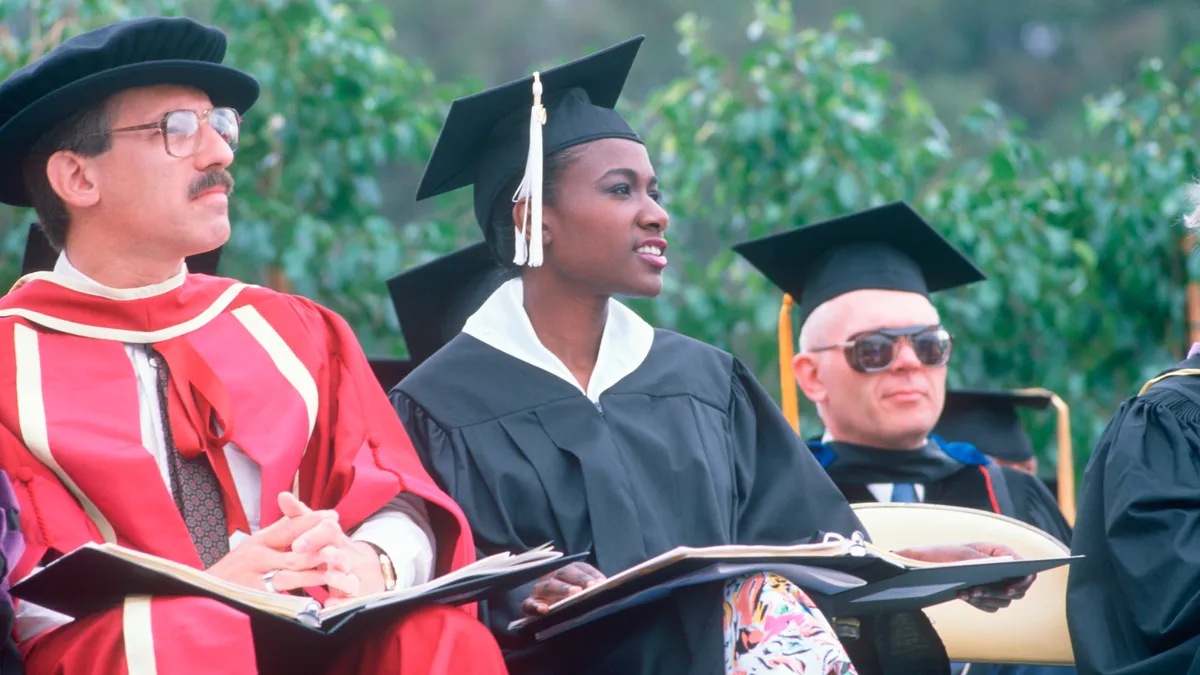Dive Brief:
- Black and Hispanic faculty members are underrepresented at bachelor's-, master's- and doctorate-level institutions, according to a new study published in the Hispanic Journal of Law and Policy.
- At bachelor's institutions, 5.2% of tenured faculty members are black and 6.6% are Hispanic or Latino. At the doctoral level, those shares shrink to 4% and 4.6%, respectively.
- White faculty members make up 78.9% of those with tenure at bachelor's institutions and 74.2% at doctoral institutions. However, the report notes, an overall decrease in the share of white faculty members hasn't been "accounted for by increases in other races and ethnicities."
Dive Insight:
The study bolsters findings that the composition of U.S. colleges' faculty is not keeping pace with an increasingly diverse student body.
Black students make up about 12% of college students, while fewer than 6% of faculty members are black, according to data analyzed by The Hechinger Report. Hispanic students account for 16% of students, even though only 5% of faculty members are Hispanic.
Those disparities can have negative effects on black and Hispanic faculty members, who often spend more time on work rarely rewarded with tenure, such as mentoring minority students or working on diversity and inclusion projects.
And there are negative consequences for students, too. The study, led by Julian Vasquez Heilig, incoming dean at the University of Kentucky College of Education, notes that faculty diversity is critical to exposing students to different perspectives and providing a well-rounded education.
Even so, predominantly white institutions have made little to no progress increasing faculty diversity, The Hechinger Report explains.
Many colleges chalk that up in part to a lack of minority doctorates in the hiring pipeline. Indeed, colleges have a long way to go in graduating more underrepresented minorities with doctorates.
In 2017, only 5.4% of doctorates were awarded to black students. And that same year, there were more than a dozen fields in which no black person earned a doctorate, The Atlantic reported.
The University of Maryland, Baltimore County is expanding that pipeline with its Meyerhoff Scholars Program. Launched three decades ago, it continues to help more black students earn STEM doctorates.
So far, it has been a success; its mostly minority students are 5.3 times more likely to go on to a STEM graduate program than those who were invited to join but went to another college instead.
Other colleges are trying to replicate the Meyerhoff program. Penn State University and the University of North Carolina at Chapel Hill have done that with similar results, and two University of California System institutions are hoping to bring it to their campuses.
However, many of the barriers to equity in hiring are beyond degree attainment, The Hechinger Report noted, including preferences for candidates from certain universities, racial bias on the part of hiring managers and whether a nonwhite candidate feels welcome at a school.
To address those issues, some colleges are baking diversity efforts into their hiring and promotion practices.
Starting this month, Kenyon College, in Ohio, will consider faculty members' diversity and inclusion work when making tenure and promotion decisions. And the University of California, Los Angeles, announced last year that it will require applicants to provide statements about their past and planned contributions to equity, diversity and inclusion.










